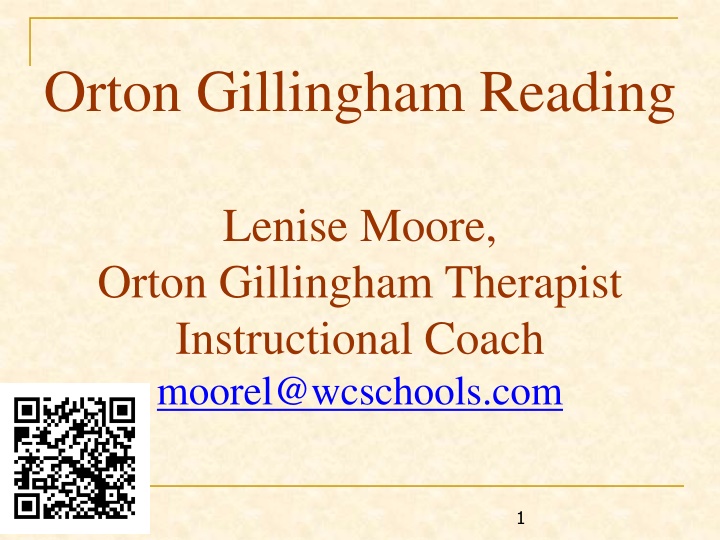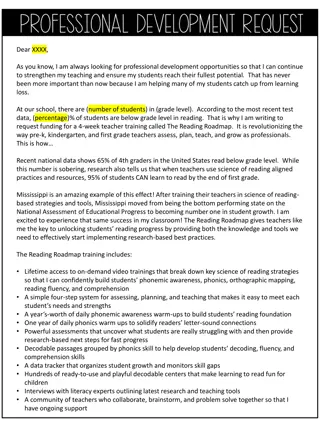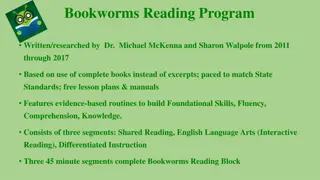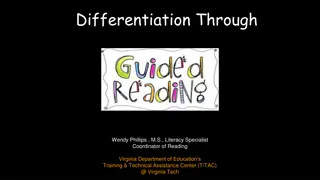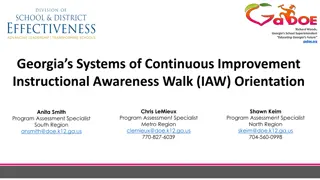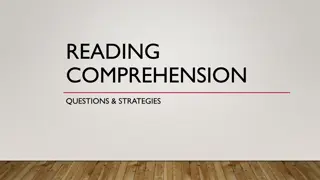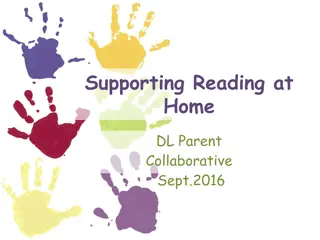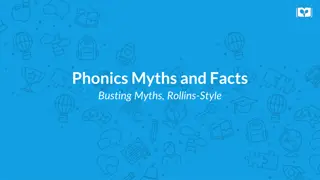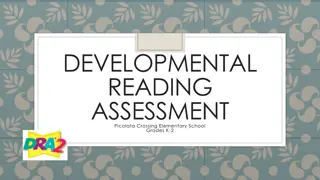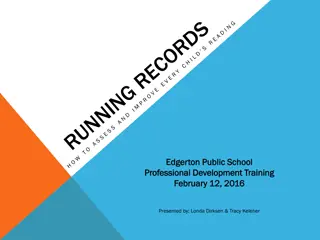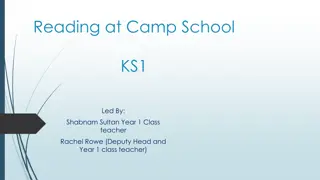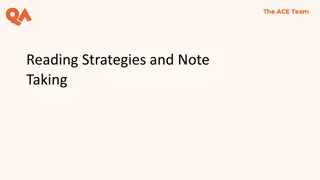Effective Strategies for Orton-Gillingham Reading Instruction
Explore essential strategies for Orton-Gillingham reading instruction, including tips for addressing letter reversals, far-point copying, phonemic awareness, tapping to decode, blending, and teaching sight words. These practical techniques, shared by Lenise Moore, an Orton-Gillingham Therapist and Instructional Coach, offer valuable insights for educators and therapists working with students who struggle with reading.
Download Presentation

Please find below an Image/Link to download the presentation.
The content on the website is provided AS IS for your information and personal use only. It may not be sold, licensed, or shared on other websites without obtaining consent from the author.If you encounter any issues during the download, it is possible that the publisher has removed the file from their server.
You are allowed to download the files provided on this website for personal or commercial use, subject to the condition that they are used lawfully. All files are the property of their respective owners.
The content on the website is provided AS IS for your information and personal use only. It may not be sold, licensed, or shared on other websites without obtaining consent from the author.
E N D
Presentation Transcript
Orton Gillingham Reading Lenise Moore, Orton Gillingham Therapist Instructional Coach moorel@wcschools.com 1
http://www.readinghorizons.com/documents/webinars/essential-need-orton-gillingham.pdfhttp://www.readinghorizons.com/documents/webinars/essential-need-orton-gillingham.pdf 2
Letter Reversals magic c Strategy: When writing magic c letters, teach students to make the letter c and teach them to write c when they begin a, d, g. Those letters will then face the right way. To distinguish between b and d , look for the magic c . Olsen, Jan Z. Handwriting Without Tears 3
Far-Point Copying We have to TEACH students how to copy. Begin by modeling - one letter at a time, then letter combinations, then words, then phrases, then short sentences. 4
Phonemic Awareness: Know your students' phonemic awareness abilities and address and build on these, daily. PA strategies are easily implemented throughout the day - transition times are a great opportunity. 5
Tapping to Decode Because students will often be holding a pencil, train them to tap with their non- dominant hand. Tap left to right, to reinforce reading left to right - right-hand, begin with pinky - left- hand, begin with thumb. Tap for each sound (phonogram), rather than individual letters - s t r e tch. Make this a natural part of reading everyday, so it becomes a habit. 6
Blending Strategy When a student struggles to read a word and tapping doesn t help: underline first sound, say sound? , underline first and second sound, say sound? , continue, as needed, to end of word, then read the word. s tretch - s s t retch - st st retch - str str etch - stre stre tch - stretch stretch c at - c c a t - ca ca t - cat cat 7
Sight Words 1. Introduce the word and discuss it. Spell and read the word 3 times (can add gestures). Spell, write, and read the word 3 times. Cover and write the word without looking. Review: Spell and read, as needed. 2. 3. 4. 5. 8
what 9
Syllabication Rabbit Words - rab-bit - Closed Syllable (ends with a consonant and vowel sound is short) Reptile Words - rep-tile - magic e Penny Words - pen-ny Tulip Words - tu-lip - Open Syllable (ends with a vowel and the vowel sound is long) Consonant -le - can-dle - ma-ple Camel Words - cam-el 10
Syllabication (continued) Hornet Words - hor-net - r-controlled Pilgrim Words - pil-grim tion/sion - con-struc-tion - man-sion Bandaid - band-aid - vowel teams Cowboy - cow-boy - compound words Violin Words - vi-o-lin Crazy i - con-ti-nent Connectives - reg-u-lar 11
Spot and Dot Syllables -Find the vowels and dot them. f a n t a s t i c 1 2 1 2 -Count the consonants between vowels. -Even # of consonants split between them unless they make only one sound. -Odd # of consonants odds are the middle consonant goes with the next syllable. t u l i p c a m e l
Barton Reading And Spelling System By Susan Barton Susan Barton s system uses a strategy similar to spot and dot , but more multi-sensory. Use letter tiles that have a different color for the vowels (including y and w). Spell the word. Use forefingers to move the vowels aside, count the consonants between the vowels, and manipulate the consonants to divide the syllables. fa nt a st i c = fan tas tic
Reverse Direction Decoding by Kenneth Wesson 1. Pre-read a paragraph, a small section of a book or a chapter. 2. Identify all unfamiliar words and difficult multisyllabic words. 3. Write them in a list form in one column. 4. Use the chart to divide those words into syllables in the second column. 5. Place your left thumb or a small rectangular piece of paper over all but the very last syllable of the word. 6. Pronounce the last syllable. 14
7. Now, uncover the last two syllables and pronounce them in their proper order, beginning with the second-to-last syllable. 8. Reveal only one additional syllable at a time, moving toward the left and away from the very last syllable. Pronounce the last three syllables in their proper order; then pronounce the last four syllables in order, etc., until all syllables have been uncovered and read in order. 9. Read the complete word three or four times, until it no longer needs to be read completely in order to pronounce it entirely. 10. The word should be recognizable and should have moved into your sight vocabulary. 15
quotation quo ta tion 16
COPS Dictation Strategy Teacher dictates the sentence Students and teacher repeat Students write the sentence Students use COPS strategy to self-check This strategy can also be used paragraphs 17
COPS Strategy for Dictation C - capitalization O - organization Paragraph indent? Does it make sense? P - punctuation S - spelling 18
C O P S the dog run the to pon 19
Fit for Life do you no what diet means some people think it means eting less food to weight lose the real meaning of diet is eating foods to stay healty a healthful diet includes fruits and vegetables those foods are grate sources of nutrients nutrients are substances that al living things need
The Take-Away: Repetition is the key. Daily practice using the OG strategies is your best friend. You can slow down skill introduction, if needed, but don't stall. Just continue to add phonograms, syllabication, and morphology, and practice daily, in everything you do. 21
Morphology Word Prefix Suffix manly mislay cloudy motionless 22
Suffixes = parts of speech: Examples: Nouns Verbs Adjectives -age -tion/-sion/-ation -ed -ize -able/-ible -cial/-cient /-ial / -tial/-tious -ful/-less/-most -ish -tious/-cious/-eous/- ous -ess/-ness -ism/-ist -ment -tiate/-ciate -fy -ship
Tic Tac Toe Variation (for large and small groups) 1.Students divide up into two groups and select X or O . 2. Teams take turns spelling words selected by the teacher (words that match the Phonics rules taught) - if they are correct, they then place X or O on the square of their choice. 3. The winner is the team that three horizontally, vertically, or diagonally. Orton Gillingham 25
Building Words The code below assigns a point value to letters or digraphs. Try to get the highest number of points by forming as many words as possible. Points 1 Letters/digraphs a, e, i, o, u 2 t, n, b, r, s, ar, er 5 c, d, g, h, m, f, p, v, w, y, ee, oa, oi, ai, ay, oy 10 j, k, q, -ck, -tch, -dge, ou, oo, ow, igh 15 x, z, -ture Orton Gillingham 26
Building Words Words Points Words Points Orton Gillingham 27
Prefix Deck - $15.00 Suffix - $15.00 Lower Level Latin Roots - $15.00 Uppler Level Latin Roots - $15.00 MSL/OG CD - $100.00 Morphology CD - $75.00 Kindergarten CD - $40.00 Add 4.71% tax and shipping. 1 -3 items $6.95 4-15 items $15.95 Contact us for larger orders. Please make your check payable to: Ronald Yoshimoto 98-410 Koauka Loop #21B Aiea, Hi 96701 28 Be sure to note shipping address.
Resources Vowel Game - Pinterest - http://fairydustteaching.com/2011/12/all-about-vowels.html Orton Gillingham Manual Ronald Yoshimoto - Orton Gillingham Therapist and Trainer - http://msl-orton.com.hk/about_us/ron.htm Barton Reading and Spelling System Susan Barton www.susanbarton.com Pinterest - www.pinterest.com - search Orton Gillingham Strategies Olsen, Jan Z. Handwriting Without Tears Pinterest - http://fairydustteaching.com/2011/12/all-about-vowels.html Kenneth Wesson - http://brainworldmagazine.com/reverse-direction-decoding/ Fictionary - Mary Bigler - www.marybigler.com 29
iPad Apps Recommended by MTSU Dyslexia Center (The grade levels listed next to each app are suggestions. Older struggling readers may benefit from some apps that are recommended for younger students, provided the content, graphics, games, and activities are appropriate.) Phonological Awareness Hear 2 Read Talking Talk (grades K-3) Webber HearBuilder Phonological Awareness (grades K-3) Phonics and Spelling A+ Spelling (appropriate for all ages and grade levels) Phonics Genius Alligator Apps (grades K-6) Sound Literacy (This app includes tilesets for teaching a wide range of phonics skills. It should be used by teachers/tutors during instruction and is not designed for students independent work. Since teachers select which tilesets to use and which skills to teach, this app can be used with students of all ages and grade levels.)
iPad Apps - continued Vocabulary (all of the apps in this category are most appropriate for secondary students) Marie s Words Quizzitive Vocab.com Fluency One-Minute Reader (materials for early first grade through middle of fifth grade) Read With Me Fluency (appropriate for all grade levels, teachers can add own texts) Comprehension Reading Comprehension - Classroom Complete Press (grades 5-8) Reading Comprehension - Peekaboo Studios (grades 3-5) Webber HearBuilder Sequencing (grades K-6) Apps with Read Aloud capabilities Reading Rainbow (most appropriate for ages 3 to 9 years) Voice Dream Reader (most appropriate for secondary and college students)
